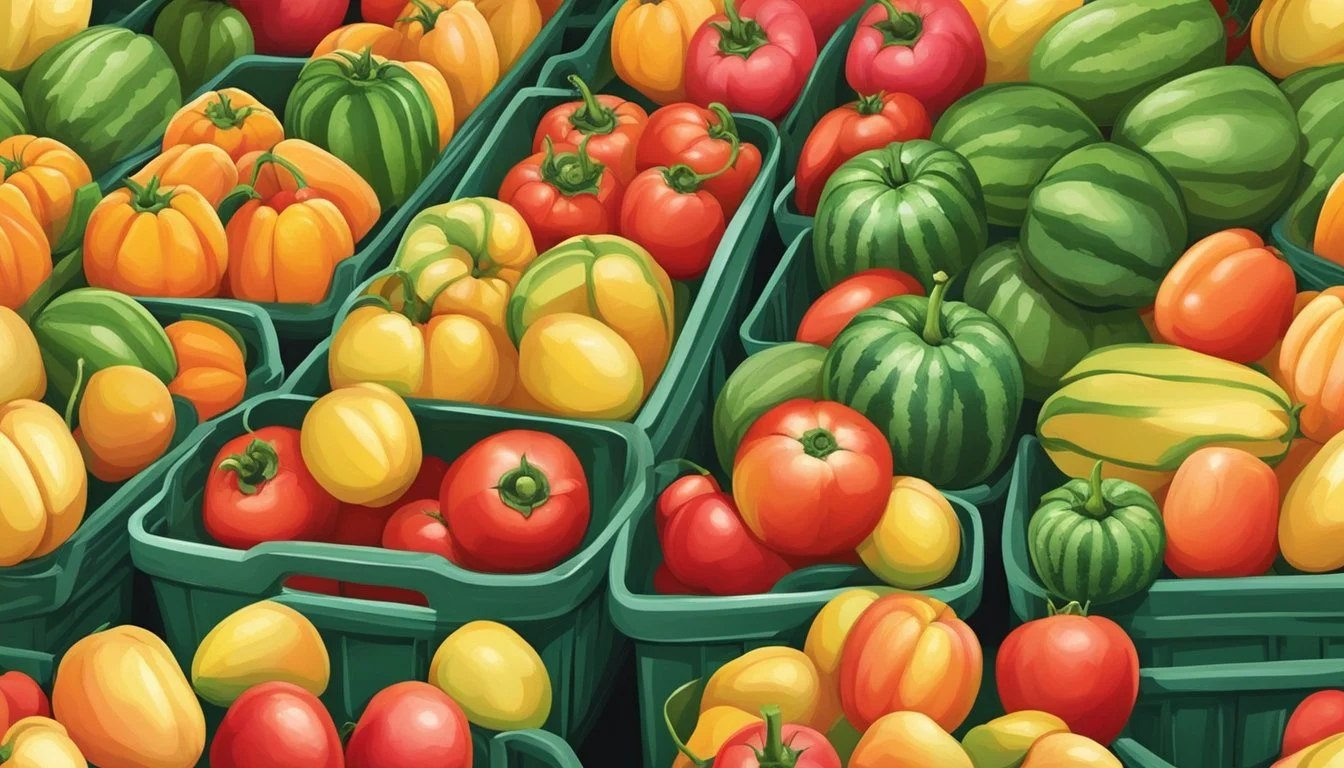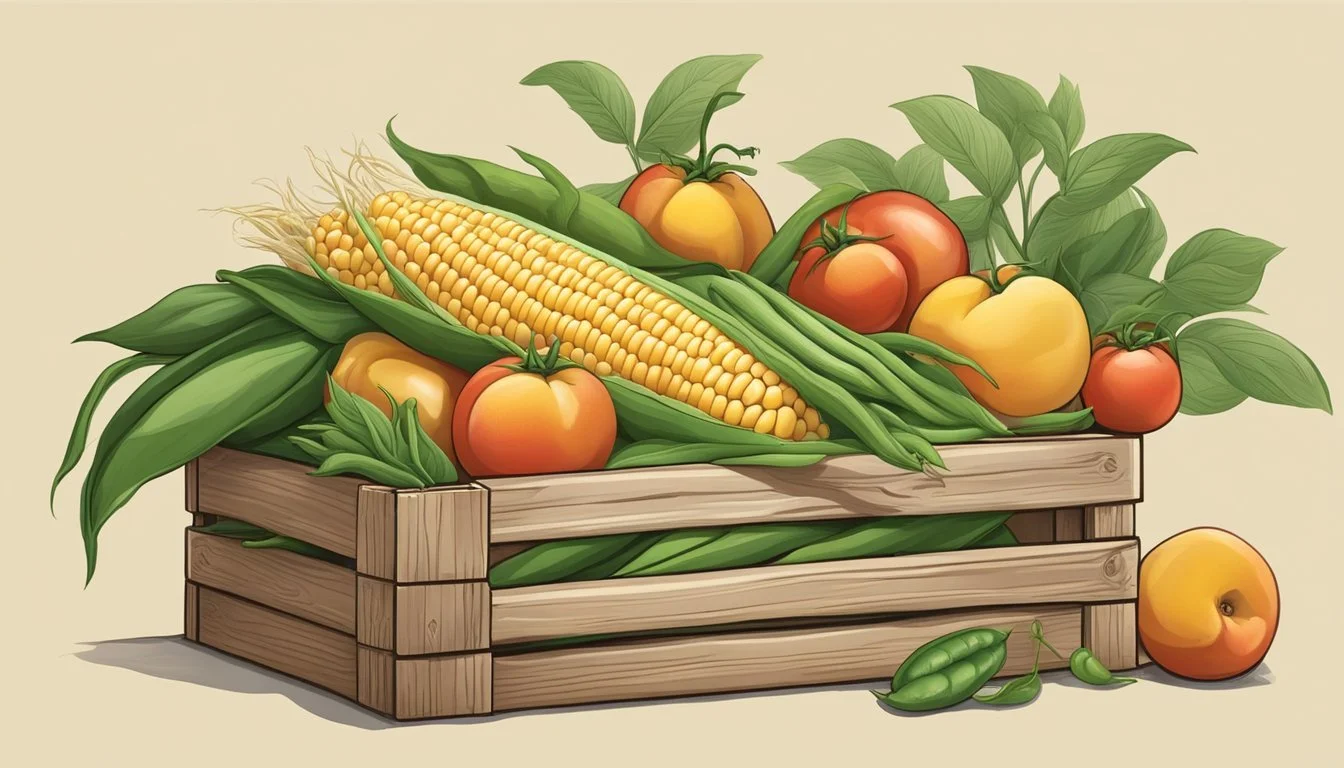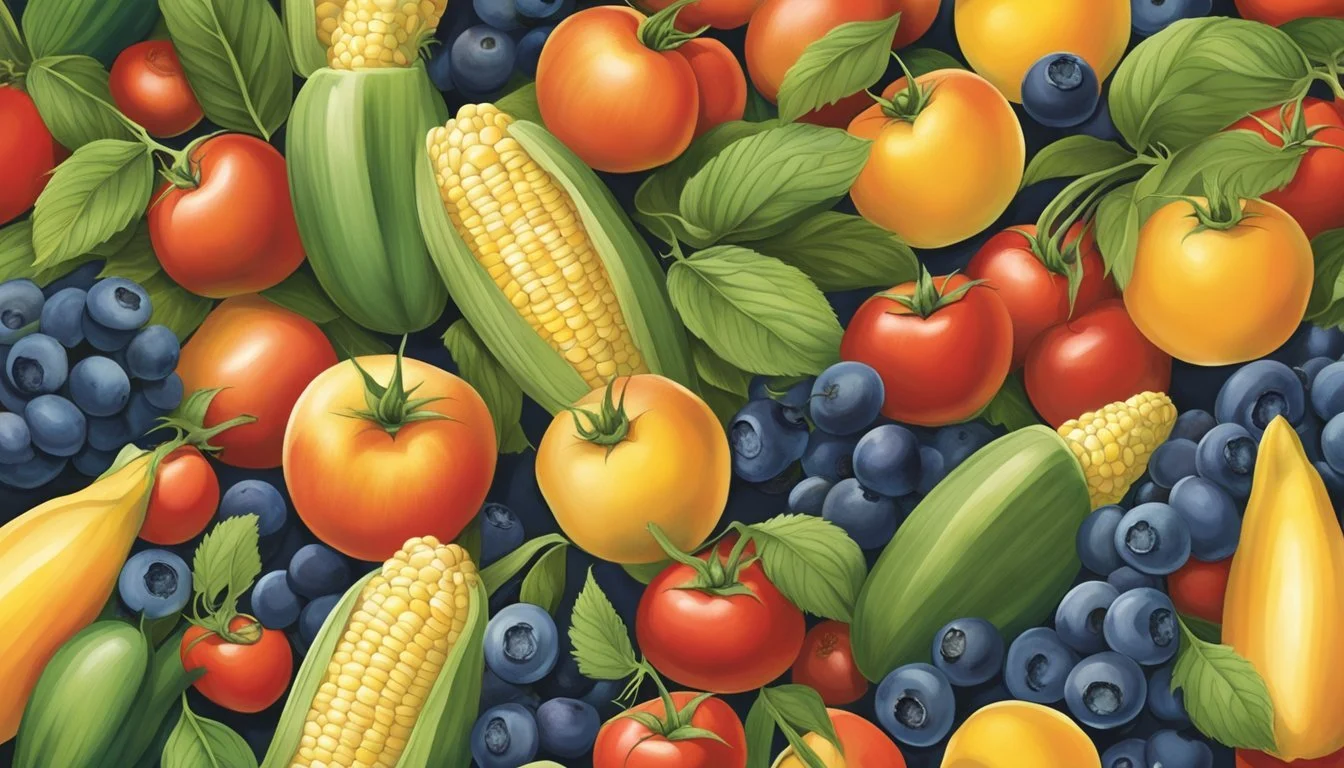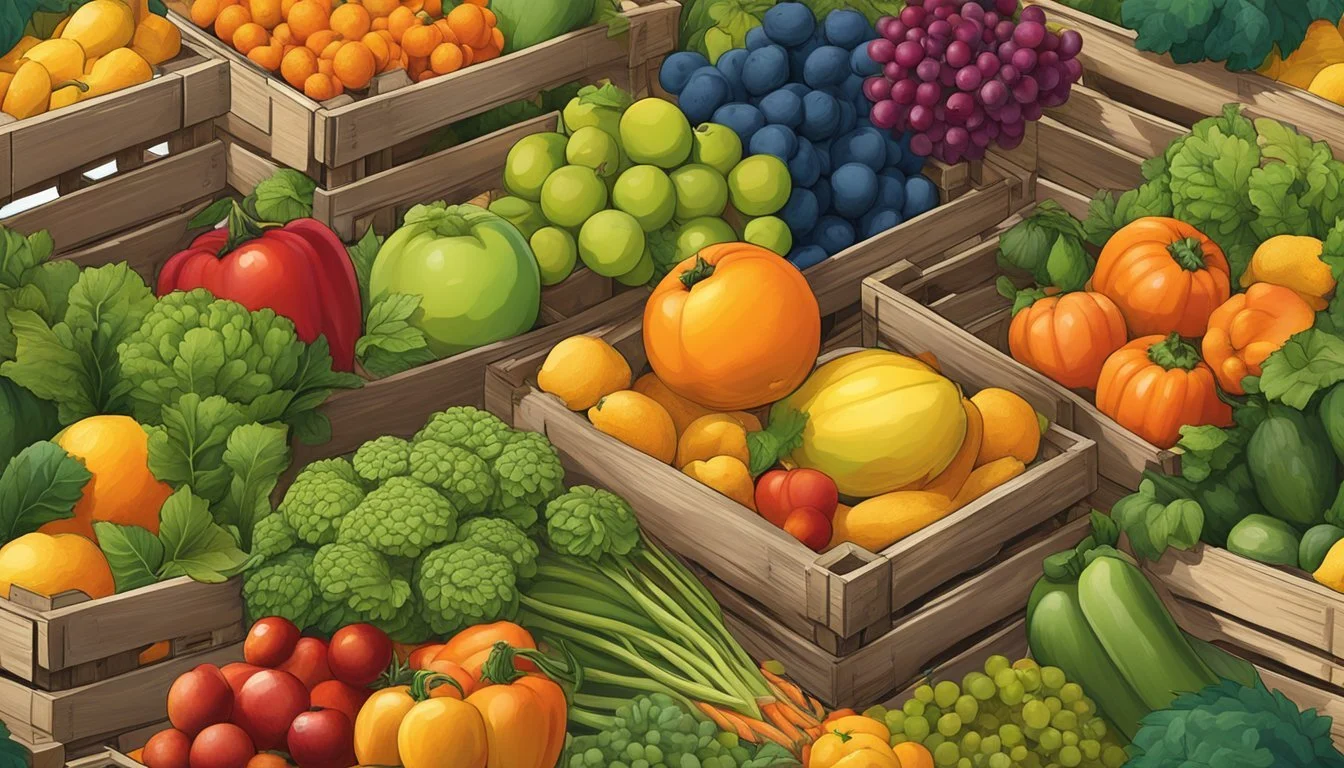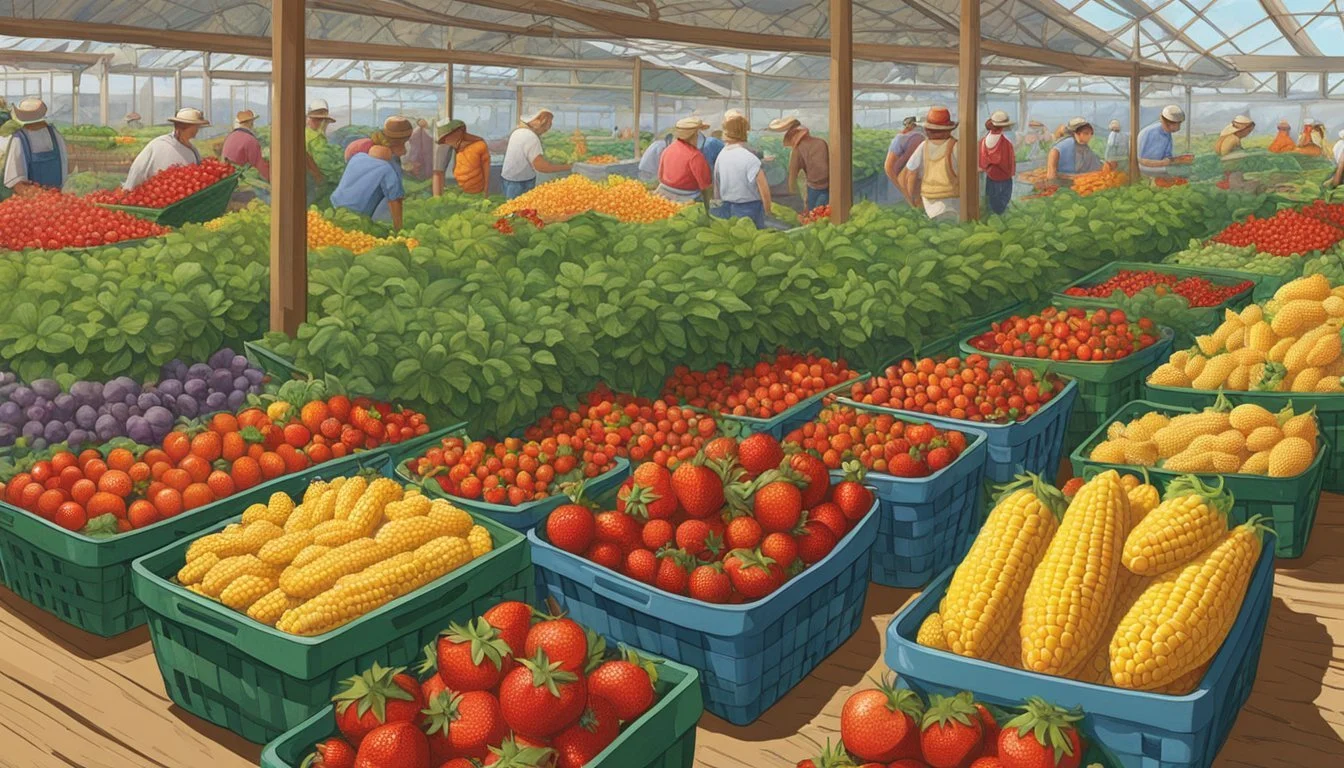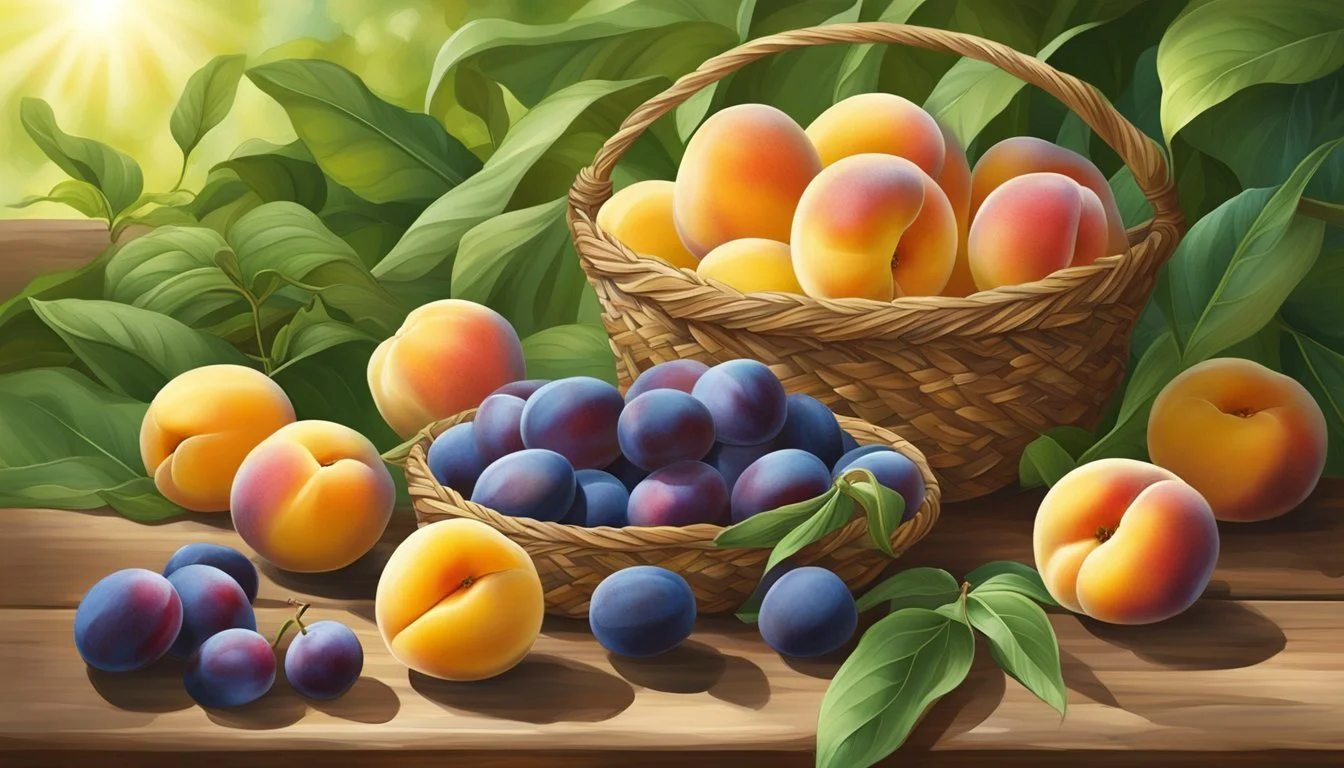Delaware Seasonal Fruit & Vegetables in August
Your Guide to Fresh Produce
This Article is Part of our Delaware Seasonal Fruit & Veg Calendar
August in Delaware brings a bounty of fresh produce as the warmth and sunlight reach their peak. Across the state, local farms and orchards come alive with vibrant fruits and vegetables, perfectly ripe and ready for harvest. These seasonal offerings provide not only a feast for the senses but also the opportunity for consumers to enjoy produce at its nutritional best, support the local economy, and engage in sustainable eating practices by consuming food grown within the region.
The fields and farm stands of Delaware become particularly lush in August, with staples such as sweet corn (how long does corn last?) and tomatoes in abundance. The long, warm days allow these crops to develop their full flavors, making them a favorite for both raw and cooked dishes. In addition to these staples, Delaware soil yields a variety of other vegetables including cucumbers (how long do cucumbers last?), green beans, and peppers, each adding color and nutrition to the summer plate.
Fruit-wise, the early to mid-month of August is perfect for savoring the sweet juiciness of local peaches and nectarines. These stone fruits reach their peak during this period, offering a special treat for both locals and visitors. The climate of Delaware in August, with its warm days and cool nights, is particularly conducive to enhancing the flavor profile of these fruits, ensuring a delightful eating experience. Farms often welcome guests to pick their own, providing a direct connection to the food source and a memorable outing for families and food enthusiasts alike.
Delaware Summer Climate and Agriculture
During the summer months, Delaware experiences a climate characterized by warm temperatures and considerable humidity. While this can pose challenges, it simultaneously creates a conducive environment for a variety of crops. Delaware's agriculture thrives in such conditions, especially when it comes to the growth of fruits and vegetables.
Summers in Delaware typically see average temperatures ranging from the mid-70s to the high 80s Fahrenheit. Such warmth is advantageous for farms focusing on heat-loving crops. The state benefits from a relatively long growing season, and by August, many of the fruits and vegetables are in full production.
With the advent of summer, Delaware farmers capitalize on the favorable weather to grow an abundant array of produce. Key amongst these are summer staples:
Vegetables: Tomatoes, corn, cucumbers, green beans, and zucchini.
Fruits: Watermelons, peaches, blackberries (how long do blackberries last?), and cantaloupes (how long does cantaloupe last?).
Particularly in August, these crops reach their peak, offering fresh, local produce to consumers. Farmers take meticulous care to ensure sustainable agriculture practices, often employing crop rotation and other methods to maintain soil health despite the high demand of summer harvests.
Delaware agriculture sectors recognize the importance of irrigation during these warmer months to counteract the occasional dry spells. Careful water management ensures crops receive adequate hydration to maximize growth and yield during this period of the year.
In summary, Delaware's summer climate is a catalyst for a flourishing agricultural season, with farms across the state yielding an impressive variety of fresh fruits and vegetables.
What's In Season in August?
During the month of August in Delaware, one can find a variety of fruits and vegetables at the peak of their freshness. The season offers an abundance of produce options for both fruit and vegetable lovers.
Fruits:
Apples (how long do apples last?): Starting to come into season, look for early varieties.
Blueberries: (how long do blueberries last?)Towards the end of their season, but still available.
Peaches: Ripe and ready for enjoying fresh or in desserts.
Raspberries: Available and perfect for jams or direct consumption.
Vegetables:
Peppers: Available in an array of colors and flavors.
Tomatoes: In full season, ideal for salads and sauces.
Cucumbers: Crisp and perfect for pickling or salads.
Sweet Corn: Harvested for its tender and sweet kernels.
In August, Delaware's produce is characterized by the full flavors and vibrant colors that these fruits and vegetables bring to the table. Farmers' markets are the ideal destinations to find the freshest seasonal picks. Consumers can expect ripe produce ready for a multitude of culinary uses, from fresh eating to preserving for later enjoyment.
Seasonal Fruit Highlights of August
August brings the peak season for various fruits in Delaware, with a particular abundance of berries and stone fruits. The warm weather of summer nurtures these fruits to their optimal ripeness, offering both flavor and nutritional benefits.
Berries and Stone Fruits
August in Delaware is a prime time for berry picking, as well as enjoying the multitude of stone fruits these warm days offer.
Blueberries continue to be available, though their season tends to wane as the month progresses. They should be firm and deeply colored with a light, silvery bloom.
Blackberries become especially sweet and plump during this period. These berries should also exhibit a deep color and be free from any redness, which indicates full ripeness.
In terms of stone fruits, several varieties reach their peak:
Peaches are particularly succulent, with a fragrant aroma and a flesh that is firm yet yields slightly to pressure.
Plums offer a delightful balance of sweet and tangy flavors, and they display a smooth, naturally shiny surface.
The collective term for these and similar fruits is:
Stone Fruit, characterized by their single large pit or "stone" inside, encompassing a variety of fruits that are plentiful in August.
Melons
Melons are synonymous with summertime freshness, and Delaware's August climate allows for deliciously ripe melon varieties.
Watermelon becomes an iconic summer treat, known for its crisp, juicy texture and sweet taste. Shoppers can look for a creamy yellow spot on the underside, indicating where the watermelon rested on the ground and ripened in the sun.
Cantaloupe, with their netted skin and fragrant aroma, reaches optimal sweetness this month. These melons are heavy for their size and should have a slightly soft blossom end.
Seasonal Vegetable Highlights of August
In Delaware, the month of August is a bountiful time for a variety of vegetables, offering an array of flavors, colors, and nutrients. The warm weather contributes to the ripening of diverse vegetable groups, making it an ideal time for local produce.
Nightshades
Nightshades thrive in Delaware's August climate. Peppers, a stand-out in this group, come in many varieties from sweet to hot, all bursting with flavor and perfect for a range of dishes. Tomatoes are also at their peak, with their juiciness and natural sweetness enhancing salads, sandwiches, and sauces alike. Eggplant (What wine goes well with eggplant?) offers a meaty texture, excellent for grilling or baking.
Peppers: Green, red, yellow, hot, sweet
Tomatoes: Heirloom, cherry, beefsteak
Eggplant: Globe, Japanese
Gourds and Squashes
Gourds and squashes offer versatility in August's harvest. Summer Squash and Zucchini are abundant, with their tender flesh being ideal for sautéing or adding to stir-fries. They are a dietary staple in Delaware for their adaptability in recipes and quick cooking times.
Summer Squash: Yellow, pattypan
Zucchini: Green, yellow
Legumes and Others
August sees the flourishing of Legumes like Green Beans, which snap with freshness. These are great for blanching and adding to salads or simply steaming as a side dish. Additionally, Corn with its sweet kernels becomes a summertime favorite, often found grilled at barbecues or boiled as a classic side.
Green Beans: String beans, wax beans
Corn: Sweet yellow, white, bi-color
The vegetables listed represent just a snapshot of Delaware's rich produce available during August, and they are key contributors to the season's culinary experiences.
The Importance of Seasonal Eating
Eating in accordance with the seasons offers a plethora of benefits, among which variety, flavor, and nutrition are notably significant.
When individuals opt for seasonal produce, they inherently diversify their diets. This variety is not merely a culinary delight but also a means to introduce a wider range of nutrients into their meals, supporting overall health. A colorful plate is more likely to cover the spectrum of vitamins, minerals, and antioxidants that the body needs.
The flavors of seasonal fruits and vegetables are particularly pronounced. Produce harvested at the peak of its season contains optimal levels of natural sugars and other flavor compounds, meaning that a ripe, August peach from Delaware will often be juicier and sweeter than one picked before its time and shipped across distances.
Moreover, the nutritional value of produce is at its highest when consumed close to the harvest. Nutrient degradation begins the moment fruits and vegetables are picked; thus, shorter farm-to-table times preserve these vital elements, offering consumers food that is not only tastier but also more beneficial for their health.
By focusing on seasonal eating, people are also more likely to support local farmers and reduce their carbon footprint, as the transportation of locally grown produce generally requires less energy and resources compared to goods shipped from afar. Therefore, the practice is a responsible choice for both personal health and environmental sustainability.
The act of choosing seasonal foods aligns individuals with the natural progression of their environment, reinforcing a connection to place and time through the simple, yet profound act of eating.
Health Benefits of Seasonal Fruits and Vegetables
Eating fruits and vegetables that are in season in Delaware during August has significant health advantages. These produce items are not only at the peak of their flavor and availability but also offer an abundance of nutrients essential for maintaining a healthy body.
Berries, such as blueberries and strawberries, come into season and are a rich source of Vitamin C and antioxidants. These compounds are vital for tissue repair and the prevention of cellular damage, respectively.
Leafy greens, including kale and spinach, are also abundant. These vegetables are packed with Vitamins A and C, as well as antioxidants which support immune function and vision, and combat oxidative stress.
Here’s a brief overview of the key nutrients in these August produce:
Berries: High in antioxidants, Vitamin C.
Kale: Rich in Vitamin A, Vitamin C, and antioxidants.
Spinach: Good source of Vitamin A, Vitamin C.
Consuming a variety of these fruits and vegetables can help to:
Boost immunity: The high Vitamin C content in berries and greens supports the immune system.
Reduce inflammation: Antioxidants in these seasonal products help reduce inflammation in the body.
Promote skin health: Vitamin A in leafy greens aids in skin repair and maintenance.
Consumers can enjoy the full taste and nutritional benefits by incorporating these seasonal offerings into their diet.
Recipes and Preparation Ideas
Delaware's seasonal produce in August presents a bounty of fresh fruits and vegetables perfect for a variety of recipes. From simple salads to the char of grilled vegetables, (What wine goes well with grilled vegetables?) the flavors of the season come to life with minimal effort and maximum taste.
Simple Salads
One can create vibrant salads using fresh August produce. A classic Tomato Basil (how long does basil last?) Salad is both refreshing and easy to prepare; simply combine sliced heirloom tomatoes, fresh basil leaves, a drizzle of olive oil, and a sprinkle of sea salt (how long does sea salt last?). For a fruity twist, a Peach and Arugula Salad pairs the sweet juiciness of ripe peaches with the peppery bite of arugula, tossed with a simple balsamic vinaigrette.
Ingredients for Tomato Basil Salad:
Heirloom tomatoes
Fresh basil
Olive oil
Sea salt
Homemade Preserves
August is ideal for making homemade Jams and Pickles. A blueberry jam can be made by simmering Delaware-grown blueberries with sugar and a touch of lemon juice until thickened. Cucumbers, abundant during this season, can be turned into crisp pickles with a brine of vinegar, water, salt, and dill.
Blueberry Jam Recipe Steps:
Combine blueberries, sugar, and lemon juice in a pot.
Simmer until the mixture thickens.
Cool and transfer to jars.
Grilled Vegetables
Grilling is a superb way to enjoy Delaware's August vegetables. Corn can be grilled for a smoky flavor and then brushed with basil butter for a herby finish. Slices of zucchini and bell peppers can be marinated in garlic, olive oil, and balsamic vinegar before grilling to make a delicious side dish or a component for a warm grilled vegetable salad.
Grilled Corn with Basil Butter:
Grill corn until charred.
Combine melted butter with chopped basil.
Brush over corn before serving.
Preserving August's Bounty
August in Delaware brings an abundance of fruits and vegetables ripe for preserving. One can capture the peak of summer flavors through methods such as canning, freezing, and making jams and pickles.
Canning is ideal for fruits like peaches and tomatoes, which can later be transformed into sauces or salsas. The high acid content in tomatoes makes them suitable for canning and later use in spaghetti sauce. They ensure safety and flavor when processed properly using a water bath.
For berries, such as blueberries and blackberries that are also plentiful, freezing is a straightforward preservation technique. Berries should be rinsed, dried, and spread on a tray to freeze initially before transferring to a freezer-safe container to prevent clumping.
Pickles are a delightful way to preserve cucumbers, offering a crunchy and tangy treat. By using a brine of vinegar, water, and salt, along with desired spices, cucumbers can be preserved through the process of lacto-fermentation.
Creating jam from August's bounty of strawberries, blackberries, and peaches enables enjoyment of the summer sweetness year-round. With the right proportion of fruit, sugar, and pectin (how long does pectin last?), one can ensure a set texture and lasting stability.
Lastly, apples start to come into season in late August, making it a perfect time to consider making apple cider. The juice from these early varieties can be spiced and preserved through pasteurization or freezing.
By employing these preserving techniques, the flavors of August can be savored long after the season fades.
Local Farming and Markets
August in Delaware is a prime month for local agriculture, offering an abundance of fresh produce. This is the peak time for consumers to engage with the community's farming efforts through numerous farmer's markets and pick-your-own farms across the state.
Farmer’s Markets
Delaware's farmer’s markets are bustling hubs where consumers can find the freshest local fruits and vegetables. In August, they are particularly vibrant, showcasing a rich variety of seasonal produce harvested at its peak. These markets serve as a direct channel between local farms and consumers, fostering a closer connection to the food source and promoting the local economy. Visitors to these markets can expect to find a selection of:
Fresh greens like kale and spinach
Aromatic herbs
Juicy peaches and plump berries
Heirloom tomatoes and crunchy cucumbers
Each market often has its own unique offerings depending on the local farms that participate.
Pick-Your-Own Farms
Pick-your-own farms offer a hands-on experience for individuals and families to engage in the picking season. During August, many farms invite the public to harvest their own produce right from the source. This activity not only provides the freshest possible produce but also educates visitors on the agricultural process.
The most common fruits and vegetables available for picking in Delaware during August include:
Blueberries
Apples
Summer squash
Sweet corn
These farms typically provide all the necessary tools for picking and offer guidance on how to select the ripest produce.
Guide to Extending the Season
To enjoy Delaware’s bounty of fruits and vegetables beyond their typical harvest times, gardeners and consumers can employ several preservation methods. Each technique can help extend the life of seasonal produce, ensuring availability even during off-season months.
Canning is a reliable method for preserving the peak freshness of fruits and vegetables. The process involves placing foods in jars and heating them to a temperature that destroys microorganisms and inactivates enzymes. This technique is suitable for a wide array of produce, including August favorites like tomatoes and peaches.
Freezing is another alternative, especially for items like berries and green beans. It’s important to blanch vegetables before freezing to preserve their texture and flavor. Fruits should be prepped and stored in airtight containers.
Below are some steps to effectively freeze produce:
Wash and dry thoroughly.
For fruits, cut into manageable pieces and remove pits or cores.
Blanch vegetables in boiling water, then quickly cool in an ice bath.
Spread items on a baking sheet to freeze individually.
Transfer to airtight bags or containers and label with the date.
For longer-term storage, root cellars offer a naturally cool and humid environment ideal for starchy produce like potatoes and carrots. In a root cellar, these vegetables can last for months without significant quality loss. It’s key to ensure proper ventilation to prevent the accumulation of ethylene gas, which can cause spoilage.
In the pantry, certain items like onions and garlic prefer a dry and dark space, extending their shelf life. Properly cured squash can remain edible for a considerable duration under pantry conditions.
By utilizing methods like canning, freezing, employing root cellars, and maximizing pantry space, Delaware’s residents can enjoy local fruit and vegetable harvests well into the winter months.
Transitioning to Early Fall Produce
August marks a significant month for Delaware's agricultural calendar as the state transitions into early fall produce. During this period, farmers and consumers alike anticipate the arrival of certain fruits and vegetables that reach their peak.
Apples and pears represent the quintessential fruits of early fall. They thrive in Delaware's climate and begin to be widely available in August. Sweet and crisp, these fruits come in various varieties with distinct flavors and textures, offering a range of options for both fresh eating and culinary use.
Apples: Harvest begins for early varieties.
Pears: Varieties like Bartlett become ripe for picking.
As Delaware enters the early fall season, hearty vegetables also start appearing in the markets. Sweet potatoes, known for their versatility and rich flavor, are sown earlier in the year and are harvested during this time. Their nutritional value and culinary flexibility make them a staple for the cooler months.
The season also introduces the ever-popular pumpkins, which are not just a symbol of fall festivities but are also packed with nutrients and can be used in both savory and sweet dishes. Pumpkins, along with other winter squashes, are planted earlier in the summer and are ready for harvest throughout the fall.
Early Fall Produce Harvest Period Apples Begins in August Pears August onwards Sweet Potatoes Harvest begins Pumpkins Ready for picking
These items represent a small snapshot of the abundant variety that Delaware's early fall produce offers, reflecting the state's rich agricultural heritage and the changing of the seasons.

